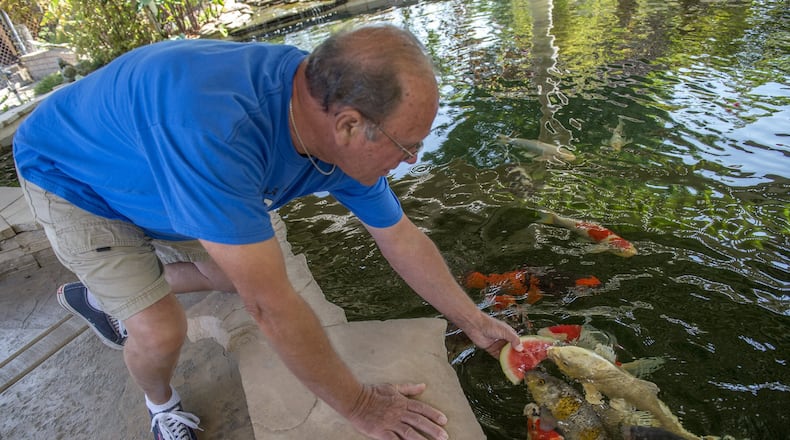GRANITE BAY, Calif. — Koi can be full of surprises.
Shiny and exotic, they gurgle and splash for attention, responding to visits from familiar people with graceful bursts of motion. Friendly and curious, they nibble softly at fingers that come close enough to stroke their slippery backs.
But what these fancy fish really want is watermelon or some other favorite snack, said Duane Carlson with a knowing smile and a plate full of fruit.
“They’ll eat right out of your hand,” he said. “Watermelon, oranges; they can’t get enough.”
In their Granite Bay backyard, Duane and Melody Carlson created a perfect pond for their 32 colorful pets. Shaded by an arbor that deters herons and hawks, the steep-sided 10,500-gallon pool also offers protection from raccoons that would rather eat koi than admire them.
“We don’t name our fish, because those are the ones you’ll lose,” Melody said. “But these fish can live a long time — 60 years or more. Most live 25, 30 years.”
Members of the carp family, koi have long been popular with California gardeners, who like to add the fishes’ glittering good looks to water features. But during the prolonged drought, interest in koi tended to dry up along with backyard waterholes.
After a seven-year hiatus, these prized fish are swimming back into the local spotlight. During Labor Day weekend, Sacramento’s Camellia Koi Club held its first public show and sale since 2010.
“We were just plain tired,” explained Georgia Vonk, a longtime koi club member, about the show’s absence. “Putting on a koi show is a lot of work and none of us are getting younger.”
Renewed interest and membership prompted the club, which includes 63 families, to bring back its popular show at a new venue, Vonk said. Dozens of 6-foot temporary tanks were be set up at The Old Sugar Mill in Clarksburg. The special fish, some worth thousands of dollars, were carefully transported to this venue where visitors could see up close what make koi so intriguing.
In Japan, koi are more than flashy fish. They embody good fortune as well as abundance and perseverance. They represent courage in the face of adversity.
At a show, these rare fish are judged on color, size, markings and confirmation. Judges look for specific color patterns such as Tancho, a single large red dot on top of a silver-white koi’s head. Highly sought after on a fish, this pattern is reminiscent of the Japanese national flag. A koi’s coloring and patterns become more distinctive with age.
The Carlsons got hooked on koi several years ago.
“The great thing about koi? They have personalities,” Duane said. “They come up to you. You can pet them.
“They’re not just overgrown gold fish. Koi have four little barbles or whiskers around their mouths like catfish. They don’t bite; they don’t have teeth.”
“But watch out; they can suck your finger out of joint,” Melody added.
Now retired, the Carlsons have lived at their Granite Bay home since it was built 41 years ago. Most of their backyard is filled with 500-plus roses, planted on mounds and around natural boulders.
One low spot always tended to be soggy, no matter how much they tried to raise the soil, Melody said. So, they turned their backyard bog into a fish pond.
In 2004, they tore out the original pond and replaced it with a perfect place for koi and the people who enjoy them. Its curved shape and depth — 42 to 78 inches — protects the fish from predators. Waterfalls and bubble stones keep the fresh water aerated and cool. And both fish and humans like the shade.
“It’s such a nice place to relax, too,” Melody said. “We love to come out here in the evening and watch our fish.”
About the Author
Keep Reading
The Latest
Featured


